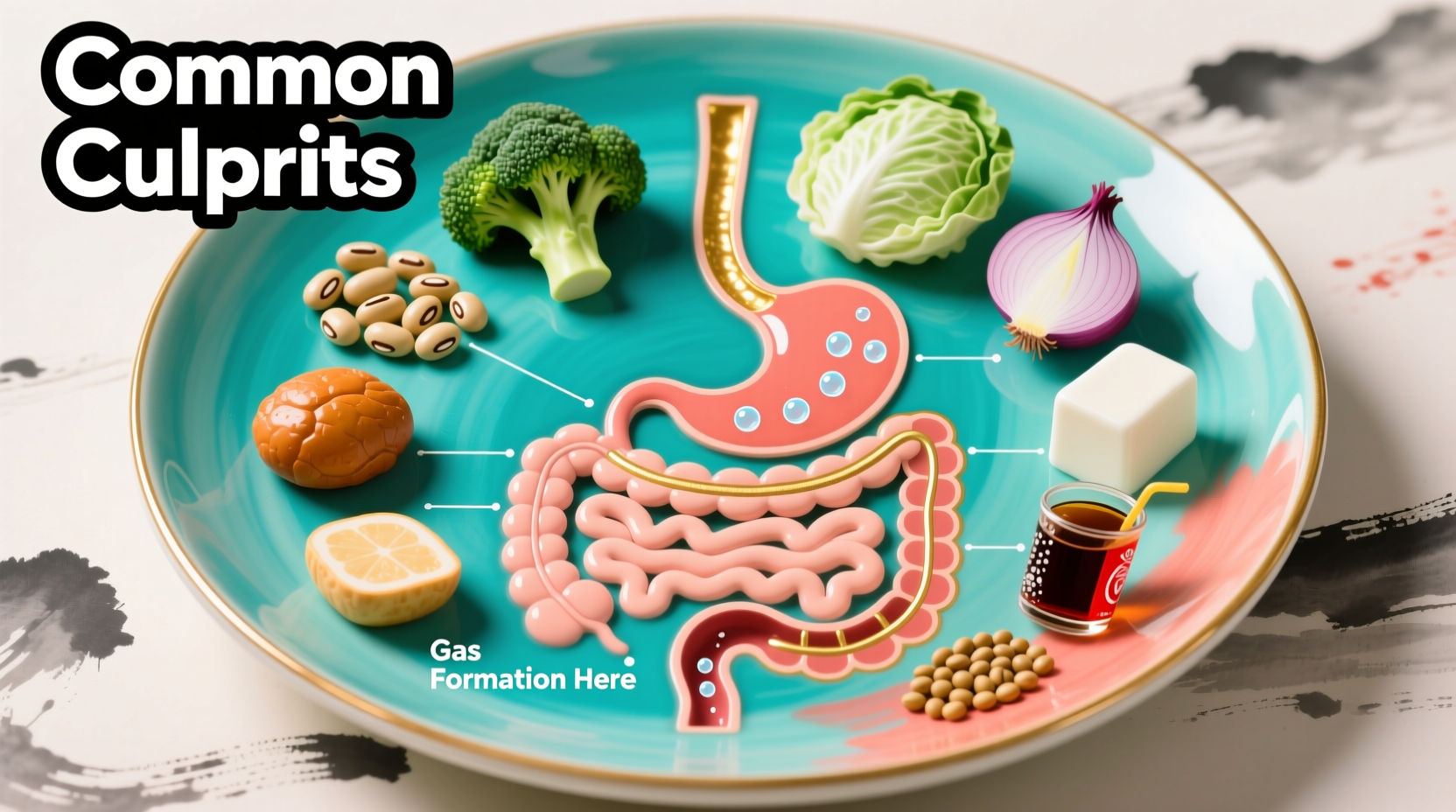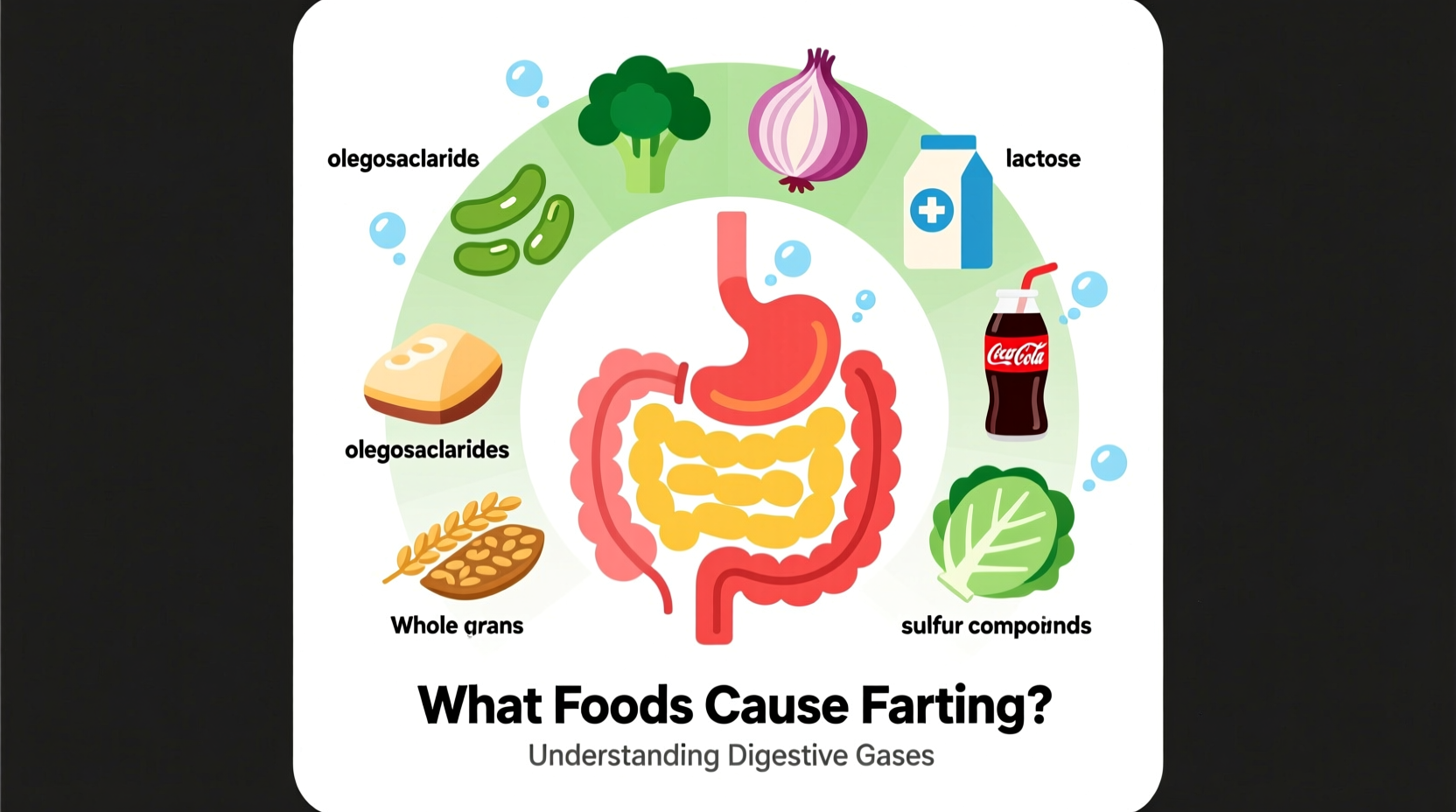The most common foods that cause flatulence include beans, lentils, broccoli, cabbage, onions, dairy products (for lactose intolerant individuals), carbonated beverages, and sugar alcohols like sorbitol. These foods contain specific carbohydrates that our digestive systems struggle to break down completely, leading to gas production by gut bacteria during fermentation.
Understanding which foods trigger excessive gas can transform your digestive comfort without sacrificing nutritional benefits. As someone who's helped thousands of home cooks navigate the complex relationship between food and digestion through my work in culinary chemistry, I've seen how targeted knowledge about gas-producing foods leads to smarter dietary choices and improved quality of life.
Why Certain Foods Cause Gas: The Science Simplified
Flatulence occurs when gut bacteria ferment undigested carbohydrates in your large intestine. While this is a normal digestive process, certain foods contain specific compounds that either resist digestion or feed gas-producing bacteria more than others. According to the National Institute of Diabetes and Digestive and Kidney Diseases, the average person passes gas 13-21 times daily—completely normal. Problems arise when frequency or discomfort exceeds this range.
Two primary mechanisms cause food-related gas:
- Indigestible carbohydrates - Complex sugars and fibers that human enzymes can't break down (like raffinose in beans)
- Malabsorbed nutrients - Substances some people can't properly absorb (like lactose in dairy)
Top Gas-Producing Foods by Category
Not all gas-producing foods affect everyone equally. Your personal tolerance depends on your unique gut microbiome, digestive enzyme levels, and eating patterns. Here's a comprehensive breakdown of common culprits:
| Food Category | Specific Foods | Gas-Producing Compound | Typical Onset Time |
|---|---|---|---|
| Legumes | Beans, lentils, chickpeas | Raffinose oligosaccharides | 6-8 hours |
| Cruciferous Vegetables | Broccoli, cabbage, Brussels sprouts | Raffinose & fiber | 4-6 hours |
| Dairy Products | Milk, ice cream, soft cheeses | Lactose (for intolerant individuals) | 30 min - 2 hours |
| Fruits | Apples, pears, peaches | Sorbitol & fructose | 2-4 hours |
| Whole Grains | Wheat, bran, barley | Soluble fiber | 6-10 hours |
Managing Gas Without Eliminating Nutrient-Rich Foods
Completely avoiding gas-producing foods means missing out on essential nutrients. Instead, implement these evidence-based strategies:
Gradual Introduction Technique
Rather than eliminating high-fiber foods, gradually increase your intake over 3-4 weeks. A 2018 study published in the American Journal of Gastroenterology found that people who slowly increased fiber consumption experienced significantly less gas after four weeks compared to those who made abrupt changes.
Proper Food Preparation Methods
How you prepare gas-producing foods dramatically affects their impact:
- Soaking and rinsing legumes - Reduces oligosaccharides by up to 50% (per USDA research)
- Cooking cruciferous vegetables - Breaks down some complex fibers
- Fermenting foods - Creates probiotics that improve digestion (sauerkraut vs. raw cabbage)
- Using enzyme supplements - Alpha-galactosidase (Beano) helps break down bean carbohydrates

When Gas Signals Something More Serious
While occasional gas is normal, certain symptoms warrant medical attention. The American Gastroenterological Association recommends consulting a healthcare provider if you experience:
- Severe abdominal pain accompanying gas
- Sudden changes in bowel habits
- Unintentional weight loss
- Blood in stool
- Symptoms that disrupt daily activities
These could indicate underlying conditions like irritable bowel syndrome (IBS), inflammatory bowel disease (IBD), or food intolerances requiring professional diagnosis.
Practical Daily Strategies for Gas Reduction
Implement these actionable tips to minimize discomfort while maintaining a balanced diet:
Eating Pattern Adjustments
How you eat matters as much as what you eat:
- Eat smaller, more frequent meals rather than large portions
- Chew food thoroughly (aim for 20-30 chews per bite)
- Avoid drinking through straws which introduces excess air
- Don't lie down immediately after eating
Strategic Food Pairing
Combine gas-producing foods with digestive aids:
- Pair beans with epazote (a traditional Mexican herb shown to reduce gas)
- Add carminative spices like ginger, fennel, or cumin to gas-producing dishes
- Consume probiotic-rich foods like yogurt alongside high-fiber meals
Individual Variability in Food Tolerance
Your digestive response to gas-producing foods depends on multiple factors:
- Gut microbiome composition - Varies significantly between individuals
- Enzyme production levels - Decreases with age for many people
- Eating speed - Faster eating introduces more air
- Stress levels - Affects digestive motility and enzyme production
Maintaining a food and symptom journal for 2-3 weeks can help identify your personal triggers more accurately than general lists. Note not just what you eat but portion sizes, preparation methods, and timing of symptoms.
Frequently Asked Questions
Why do beans cause more gas than other foods?
Beans contain oligosaccharides (specifically raffinose) that human digestive enzymes can't break down. These complex sugars reach your large intestine intact where gut bacteria ferment them, producing hydrogen, methane, and carbon dioxide gases. Soaking and thorough cooking reduces but doesn't eliminate these compounds.
Are some people naturally more gassy than others?
Yes, individual differences in gut microbiome composition, digestive enzyme production (like lactase), and intestinal transit time significantly affect gas production. Genetic factors influence your ability to digest certain carbohydrates, and gut bacteria populations vary dramatically between individuals based on diet, antibiotic use, and other factors.
Does drinking water help reduce gas?
Adequate hydration supports proper digestion and can help move gas through your system more efficiently. However, drinking large amounts during meals may contribute to bloating. The National Institutes of Health recommends drinking water between meals rather than with meals to minimize air swallowing and support optimal digestive function.
Can exercise help relieve gas buildup?
Yes, gentle physical activity like walking stimulates intestinal motility and helps move gas through your digestive tract. A 2019 study in the Journal of Neurogastroenterology and Motility found that 30 minutes of moderate exercise after meals reduced bloating and gas symptoms in 68% of participants with functional digestive disorders.
Why do I experience more gas at night?
Digestive processes slow during evening hours as your body prepares for rest. Gas-producing foods consumed earlier in the day may continue fermenting while your digestive motility decreases. Additionally, lying down positions can trap gas differently than upright positions. Eating your largest meal earlier in the day and avoiding late-night snacks can help reduce nighttime gas discomfort.











 浙公网安备
33010002000092号
浙公网安备
33010002000092号 浙B2-20120091-4
浙B2-20120091-4